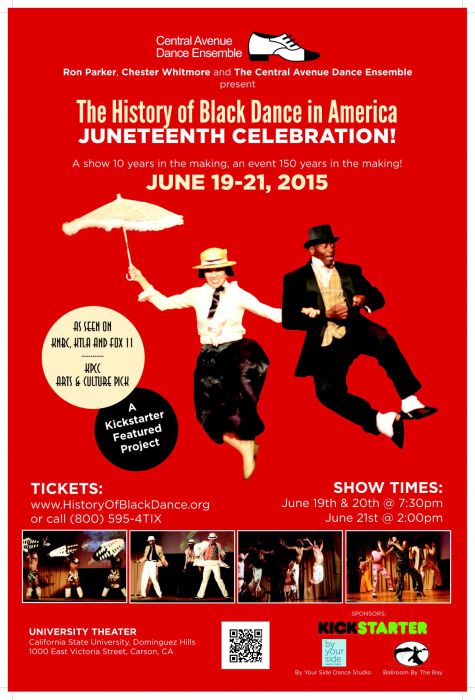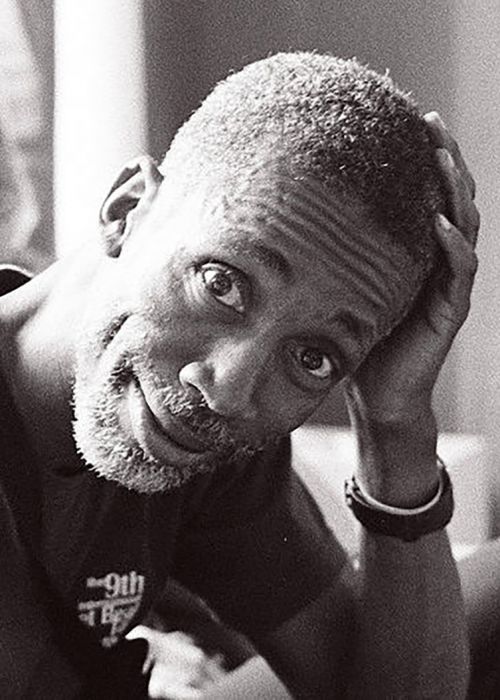
Providing its audience a jaunt through history via song and dance originated during the time of slavery, the Jazz era and contemporary times, the multi-media dance concert “The History of Black Dance in America” will run at California State University, Dominguez Hills’ (CSUDH) University Theatre for three nights, June 19, 20 and 21.
Produced by Ron Parker and Chester Whitmore, a renowned choreographer, tap dancer, lindy hop instructor and dance historian, and performed by their Central Avenue Dance Ensemble, “The History of Black Dance in America” (HBDA) celebrates the historic and cultural contributions of African Americans in the United States with authentic renditions of such dances as Zulu Work, Cakewalk, Lindy Hop, the Foxtrot, and African-inspired Latin-American dances.
 Dubbed “A show 10 years in the making. An event 150 years in the making,” HBDA is now in its fifth consecutive year in its current arrangement.
Dubbed “A show 10 years in the making. An event 150 years in the making,” HBDA is now in its fifth consecutive year in its current arrangement.
“The original ‘The History of Black Dance in America’ show that Chester had toured around the world 20 years earlier, and the one I was a part of in 2005, focused primarily on vernacular jazz dances of the early 20th Century. It did not include Argentine Tango, the ballroom dances, the Latin dances, Disco or Hip Hop,” said Parker, who now produces much of the show himself. “I recognized that many of these were also vernacular dances, created or inspired by the descendants of African slaves, and were indeed a part of the history of black dance in America. As it happens, I had a degree of experience and expertise in many of these dances that would be useful in incorporating them into the presentation.”
“The History of Black Dance in America” takes place in CSUDH’s University Theater on June 19 and 20 at 7:30 p.m., and June 21 at 2 p.m. For tickets visit here or call (800) 595-4849.
Celebrating Juneteenth
This year, “The History of Black Dance in America” will also highlight the 150th anniversary of “Juneteenth,” the oldest celebration in the nation of the end of slavery.
Juneteenth, also known as Freedom Day or Emancipation Day, commemorates the date of June 19, 1865, when Major General Gordon Granger led union soldiers to Galveston, Tex., to announce the end of the Civil War and the abolishment of slavery. Granger’s announcement came more than two years after President Abraham Lincoln’s signing of the Emancipation Proclamation in 1863.

“In my mind, there is no more important black ‘holiday,’ because without the Emancipation Proclamation, and for that matter, the Civil War itself, American black history looks nothing like it does today–no King Day, no Black History Month, no BET Award,” said Parker. “And with that, perhaps no Cakewalk, Charleston, Black Bottom, Lindy … etcetera. I like the fact that, in addition to educating the public about black dance history, I am also making everyone more aware of a celebration that is perhaps our most culturally significant in this country after Independence Day.”
Laura Talamante, associate professor in CSUDH’s Department of History, which is co-sponsoring the show, agrees with the historical significance of Juneteenth, and believes the HBDA brings it to life through a “stunning display” that highlights the influence African Americans have had on shaping American culture; that the history is “inseparable from our overall American story.”
“The Department of History is extremely pleased to co-sponsor this event. The origins of black dance reflect how African-Americans retained their cultural roots while their slave labor enriched and expanded the United States economy and international power,” said Talamante.
Central Avenue Dance Ensemble
Rooted in Los Angeles history, the Central Avenue Dance Ensemble is named after the legendary “Central Avenue” district of the city, which was Los Angeles’ African-American cultural and entertainment hub during the early part of the 20th Century.

In 2005, Parker, who had been working with the ensemble for a few years, was working with Whitmore to prepare HBDA for the UCLA African-American Music Festival at Schoenberg Hall, which was its biggest show to date.
“We worked for a couple of months on some 20 or so routines. But I thought then that we really needed to present this show to the general public. It was filled with so much rich and interesting and generally unknown history, and it was a shame to do all this work for just one presentation to a small audience,” said Parker.
“While Chester Whitmore provides tremendous help as artistic director, he’s usually traveling around the world teaching and performing. So, I am left here as the director, producer, choreographer, etcetera,” said Parker. “It’s a lot of work, but I do it because it is important work.
“We are telling dance history that is not told anywhere else,” he added. “Vernacular jazz dance, the original American dance form, and its history is not performed by major American dance companies, nor is it funded by the major arts funding organizations. If we don’t do it, no one else will.”